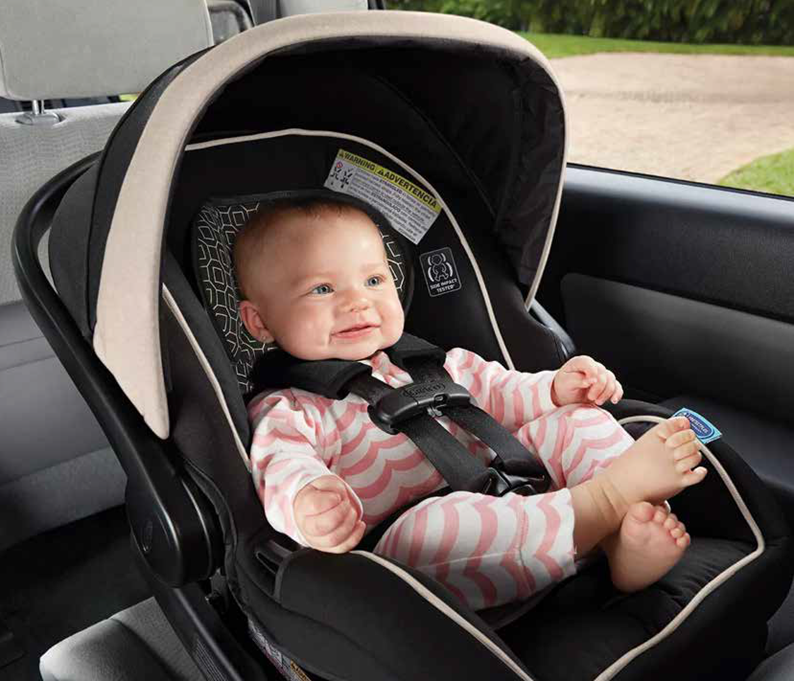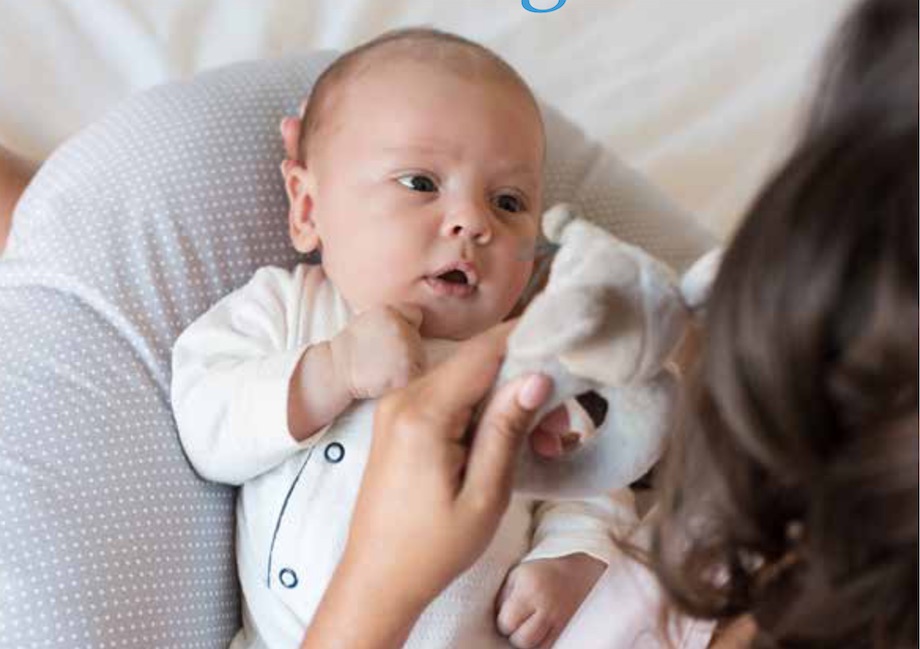
Placing your baby on your bare skin encourages baby to feed as soon as possible after the birth. Newborn babies are placed straight onto their mothers as soon as they are born. This skin-to-skin contact with you after birth is good for your baby’s physical health such as regulating their temperature & heart rate, as well as helping you to bond with each other
The first feed
Usually, within an hour of birth, your baby will normally start to show interest in breastfeeding. Baby will:
- feel the warmth of your body and your body rhythms
- recognise your voice
- smell the breast and start to push upwards towards the breast
- use newborn behaviours such as the rooting reflex and sucking reflex to find the breast. Your midwife will help you to position your baby for breastfeeding and make sure that baby has a good latch on your breast.
The latch
A good latch is the key to successful breastfeeding. You will know if baby has a good latch if their chin is touching your breast and their nose should be reasonably clear. Baby’s bottom lip will be turned outwards and not turned inwards. To start with, they’ll be sucking quite quickly, but once the milk starts to flow, they’ll change to rhythmic, longer sucks with some short pauses. You’ll also start to hear baby swallowing – this will happen more as your milk comes in and flows more. Your baby’s cheeks should stay rounded when sucking.
Breastfeeding should feel comfortable. If it doesn’t feel comfortable – start again. Slip your finger into the corner of your baby’s mouth between their gums, with the soft side (not the nail) next to the lip so that you gently break the suction.
If you run your tongue along the roof of your mouth, you will feel it changes from the hard palate to the soft palate at the back. Babies need to take in a large mouthful of breast (not just the nipple) and your nipple needs to be in the baby’s soft palate. A quick way to check this from the first breastfeed is the shape of your nipple after the feed. If it is pointed or lipstick shaped, your nipple was probably against the hard palate of baby’s mouth and this continues, it can cause problems. If you feel pain in your nipples or breasts, ask your midwife for help or talk to a lactation consultant.
Breastfeeding positions
There are many ways to breastfeed your baby and you will find what works for you. One of the best ways for mums and newborns to learn to breastfeed together is the “laid back” or “natural breastfeeding position”. This allows babies to use their innate newborn reflexes to find the breast and get a deep latch. This involves the breastfeeding parent getting into a comfortable, semi reclined position and lay baby on top, near the breast.
You can watch more about this position in this video What adjustments make early breastfeeding easier?
Some other popular breastfeeding positions are:
Cross-cradle
It’s often easier to start breastfeeding by holding the baby in the cross-cradle position. This means that the baby’s head is supported with your hand at the base of their neck. The position of your hand is important as the baby needs to be able to tilt their head back slightly. Make sure that your arm or hand is not behind the baby’s head, or they might not be able to tilt it back. Your other hand is supporting your breast.
Cradle hold
Once baby is latched well, you can change to a cradle hold, which might be more comfortable. Release your hold on your breast (unless it is very heavy and full, in which case you may need to support it during the feed) and move your arm gently around the baby.
Other positions
The underarm or rugby hold can also be useful if your breasts are heavy, as the weight is partially supported by the baby.
Whatever position you use, make sure:
- Baby is snuggled in close ‘tummy to mummy’, If you can see your baby’s tummy button, they’re not turned close enough to latch well.
- Baby’s chin touches your breast and baby’s nose lines up with your nipple. Remember “Nipple to nose”
- Your baby has a mouth open wide to get a good latch.
Baby’s hunger signs
Babies will let you know when they are ready for a breastfeed. These hunger signs may happen with their eyes closed or open:
- rooting around with the mouth – opening the mouth and turning their head as if looking for the breast
- sucking movements and sucking sounds
- the tongue coming out of the mouth and almost licking the lips
- hand-to-mouth movements
- sucking the fingers or hand
- opening the mouth and possibly turning the head in response to a touch around the mouth area.
These are often called early hunger signs and it may seem when your newborn is awake, they will be exhibiting these signs! Try to feed your baby before they are very hungry as it is easier to latch a calm baby, than a crying baby.
New babies need to feed at least eight to twelve times around the clock. . As your baby is quickly growing and developing, some days they will need to feed more often. Our body’s are clever and your milk supply will adjust to your baby’s demand. Every time your baby suckles, your body gets the message to release milk and make more. So the more you feed your baby, the more milk your body will produce.
Supporting breastfeeding
Breastfeeding can be challenging – and it can be tiring, particularly in the first forty days as the breast milk supply is getting established. Support from dads/partners, whānau and friends can make all the difference. There are many things that can be done to support mothers to breastfeed.
- offer to help with the other children – read them a story or play with them
- help around the house – do the dishes or the grocery shopping. Hang out the washing, do some cleaning or make the school/preschool lunches
- help mum to get the rest she needs by spending time with the baby. As an added bonus, helping out by caring for an infant gives dads/partners and support people a chance to bond with baby as well. You could bath baby, burp them after a feed, or cuddle and soothe them. And don’t forget to help with nappy changing!
- aim to make at least the first ten days after the birth a ‘babymoon’ for the new mother – free from cooking, cleaning and childcare, unless she chooses.
Make sure you get enough energy
Eat regularly, and make sure to eat a variety of healthy foods every day. You can read more about eating for breastfeeding women here.
You need to drink plenty of water when you’re breastfeeding too.
Some women may need special advice from a dietitian about eating. You may wish to ask your midwife to arrange an appointment with a dietitian if you:
- find that certain foods that you eat are affecting your baby
- have a medical condition that affects what you eat, such as diabetes
- eat very little or have a history of eating problems
- are vegetarian or vegan.
This article was prepared with support from the Ministry of Health and La Leche League.
Other useful video links:





